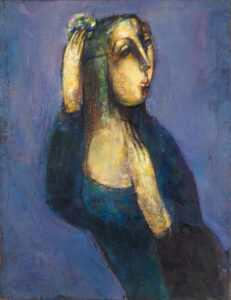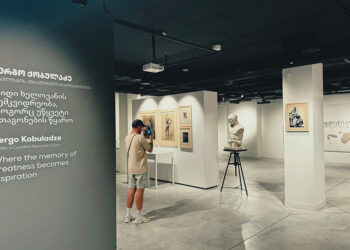The visual art of 20th-century Georgia, shaped by complex political and social forces, offers a layered and often fragmented narrative. Much of it remains obscured, demanding deeper scholarly attention. Within this context, archives play a vital role: documenting and identifying artists marginalized or excluded from dominant cultural narratives, and helping to restore histories that were forgotten, suppressed, or erased.
Thanks to the Art Foundation Anagi (AFA), in a strategic partnership with Reach Art Visual, many of these long-silenced voices are being brought back into view. The Foundation’s collection—assembled from both Georgian and international sources—holds a vast trove of under-researched works, primarily from the mid-20th century.
It includes both celebrated figures of Georgian modernism and lesser-known or entirely unknown artists who vanished from the historical record, lost to ideology or circumstance. Among the collection are even works by unidentified creators, catalogued simply as “unknown artist”—their legacy on the verge of disappearing into the folds of history. Yet through the dedicated efforts of art historians and researchers, many of these names have been recovered and reintroduced in recent years.
Now, Bonhams—one of the world’s most respected auction houses—has dedicated a sale exclusively to contemporary Georgian art, running from May 19 to May 29. Among the featured works are those by Gregor Danelian and Gaioz Kotrikadze, two remarkable artists recently rediscovered within the collection, now returning to the public eye.
Gregor Danelian: A Visionary of Light and Spirit
One of the works on view at Bonhams is Veil of Serenity by Gregor Danelian (1950–2021). Born in Tbilisi on May 28, 1950, Danelian studied at the Yerevan Art Institute and spent his final years in Minsk. Over a decades-long career, he explored a wide range of styles and media—from Cubism, Symbolism, and Expressionism to Pop Art and collage—consistently working outside the constraints of Soviet ideological dogma. In his later years, his art took a more spiritual turn, shaped by his practice of Raja Yoga and meditation, and infused with metaphysical, religious, and ethnocultural themes.
Today, his works are held in private and public collections across Georgia, Armenia, Austria, Germany, the Netherlands, Israel, the UK, the US, and beyond.

According to Tbilisi-based art historian and curator Kote Bolkvadze, Danelian’s body of work—spanning expressive metaphysical canvases, black-and-white graphics, and sanguine drawings—embodies a distinctive synthesis of Armenian grotesque, Georgian cultural harmony, and modernist experimentation. Bolkvadze describes him as a quintessential figure of the Tbilisi-Armenian school, remembered for his singular voice alongside renowned artists of Armenian heritage in Georgia, such as Sergei Parajanov, Gayane Khachatryan, and Albert Dilbarian.
Another of Danelian’s works, Enigmatic Assembly, appeared in Bonhams’ “British and European Art” auction in July 2024, selling for $24,600—exceeding its low estimate by 92%.
Gaioz (Giorgi) Kotrikadze: A Cuban Dream in Soviet Modernism
Another “forgotten” artist featured in Bonhams’ inaugural Georgian auction is Gaioz Kotrikadze (1915–2005), whose Cuba series—created in the 1960s—offers a surreal, stylized vision of Havana filtered through the lens of socialist optimism. Executed in felt-tip pen on paper, often accented with gouache and washes, these works reflect the spirit of ‘political camaraderie’ between the USSR and Cuba—a cultural alliance that sparked a wave of artistic exchange across the Soviet bloc.
Kote Bolkvadze draws a parallel between Kotrikadze’s visual language and Mikhail Kalatozov’s I Am Cuba (1964), the haunting, poetic travelogue co-produced by Soviet and Cuban studios. “The city is not simply drawn,” Bolkvadze observes. “It is observed, absorbed, and reimagined through a distinctly Georgian modernist gaze. Kotrikadze hallucinates with precision.”

43 × 30 cm
According to family accounts, Kotrikadze met Fidel Castro during the latter’s visit to Georgia and was personally invited to work in Cuba—a story that lends a cinematic mystique to the series. But the true magic of these drawings lies not in biography, but in form: urban vignettes stripped of individuality, shimmering with Caribbean heat, shaped by formalist curves and architectural waveforms. These are not depictions of Havana—they are distilled impressions, geometric echoes of a tropical dream refracted through the Cold War’s ideological and aesthetic lens.
This season, the Bonhams auction marks a significant step in recontextualizing and reclaiming the legacy of Georgian modernism. By renewing attention to artists like Gregor Danelian and Gaioz Kotrikadze—figures long overlooked or forgotten—it becomes more than a commercial event. It is also a cultural reckoning: a reminder that art’s role is not only to preserve, but to rediscover. As these “forgotten masters” return to the international stage, a richer, more inclusive narrative of modern Georgian art begins to take shape.
Georgian Art Now, which marks the first historic sale of Georgian works at a major international auction house, is open for bidding. The sale closes on May 29. For details please visit.














